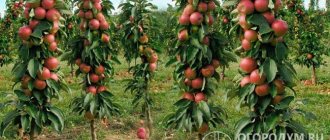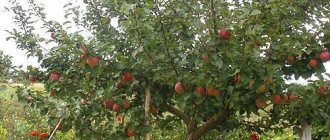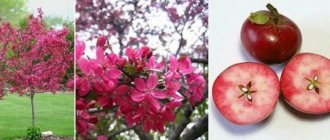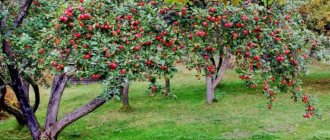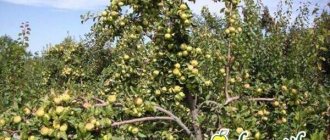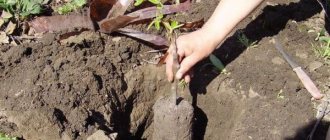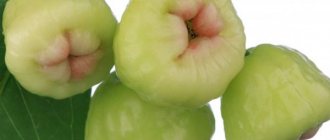Columnar varieties of apple trees are becoming increasingly popular, because they are small in size and have good yields. At the same time, many advantages of certain varieties will help you choose the ones necessary for the conditions of the region and the requirements of gardeners. The President columnar apple tree arouses interest and respect for its abundant harvest of large fruits.
Apple tree variety President.
Description of the variety
The President variety is semi-dwarf, its height is up to two meters. The decorative crown is similar to a column; short ringlets are densely located on the trunk. Despite its apparent fragility, the apple tree is dense and the trunk is strong and can even withstand a lot of weight.
Fruits develop very early, even from the second year. The yield is quite decent; abundant annual fruiting lasts about 15 years with good care. The apple tree has a good root system, which is quite rare for columnar varieties.
Advantages and disadvantages of the variety
The President variety has many positive qualities. The advantages include:
- frost resistance;
- survival rate;
- fruiting;
- ease of care;
- unattractive to pests;
- rare diseases.
See also
Description of the Aelita apple tree variety, frost resistance characteristics and growing regionsRead
There are also many disadvantages, among them the high cost of seedlings and poor keeping quality of fruits. Another significant disadvantage is the short lifespan of the culture.
Characteristics
The President apple tree has a number of special characteristics that need to be considered before planting the crop on the site.
Mature tree size
An adult apple tree grows 2, sometimes 2.5 meters. The internodes are located close to each other and quite densely, making it really look like a green column.
Annual growth
The growth is average by the standards of semi-dwarfs. Typically, the crop grows by 7-8 cm per year.
Frequency of fruiting
The President apple variety does not tend to be periodic and bears fruit annually. Typically the harvest amount reaches 8 kg; under good conditions it can increase to 12 kg. With industrial plantings and maintaining the agricultural background, this figure can increase to 16 kg.
Winter hardiness
The apple tree's disease resistance is declared to be high. For comparison, it is similar to Melba or Antonovka. But such stability is ensured only through proper care during the season and shelter.
Disease resistance
Immunity is at a high level, ordinary apple diseases are not terrible for the President columnar apple tree variety. But to maintain it, preventive spraying is necessary.
Preventive spraying of apple trees against diseases.
Tasting assessment
The fruits are yellow-green, slightly ruddy. The skin is thin, but quite dense. The pulp is fine-grained, soft and juicy. President columnar apples received very high scores on the tasting scale: from 4.8 to 5.
Advantages and disadvantages
The President apple tree has many advantages. But there are also disadvantages that you should be aware of.
Advantages
There are a lot of positive properties. Among them:
- compact size due to the absence of long branches on the sides;
- precociousness;
- good ability to take root and even tolerate transplantation;
- a large amount of harvest;
- good quality fruit;
- immunity at the highest level.
All these positive properties are successfully combined with the compact size of the President columnar apple tree, which greatly facilitates the process of care and harvesting.
Flaws
The cost of seedlings of columnar varieties is quite high, which is a significant disadvantage. But they need to be carefully looked after; they require special attention.
Pests and diseases
With regular preventative spraying, diseases and pests rarely plague the columnar apple tree President, but it is still necessary to know the signs of the most common problems.
Scab
A fungal disease that attacks young shoots. It is characterized by the appearance of green spots of various shades, which gradually darken.
Powdery mildew
Fungal disease. Whitish spots appear on the leaves and bark.
Bacterial burn
The disease is caused by bacteria that develop intensively in the warm, humid season. Tree branches darken, gradually acquiring a black color.
Aphid
A small, translucent insect that sucks sap and nutrients from young parts of the tree.
Mite
A very small insect. The appearance can be noticed by convex areas on the leaves and fruits of the apple tree. The affected parts turn black over time.
Features of planting and care
Planting columnar varieties is slightly different from planting a regular apple tree, but not in many ways.
Planting scheme for columnar apple trees.
Deadlines
The procedure for planting an apple tree can be carried out in spring or autumn. When planting in spring, you need to prepare the planting hole in advance; it is better to do this in the fall. The time must be chosen so that the soil has already warmed up, but the buds have not yet blossomed.
Features of planting in autumn
In order to properly plant the President apple tree in the fall, you need to prepare a hole in advance. The procedure must be carried out three weeks before the cold weather, so that the roots have time to form in the soil, but do not have time to grow.
It is considered that autumn planting is preferable. During this time, the plant strengthens significantly, and it does not suffer from spring frosts.
Distance between seedlings when planting
The advantage of President columnar apple trees is that they take up very little space. The minimum distance between plantings should be 60*100 cm. But this is for a dense planting. And if there are only a few plants on the site, then the distance may be greater.
Correct fit
The pit is prepared in advance; if necessary, drainage is made at the bottom. With the top layer of fertile soil in the hole you need to place compost, superphosphate and potash fertilizers. For columns you need 10 times less quantity than for regular ones.
Proper planting of an apple tree.
Growing technology and care features in the first year
Columnar varieties of apple trees differ in the intensity of their development. It is very important to pay attention to the harvest from the first year. A lot of ovaries are formed on the hybrid from the first year, so they need to be normalized. It is best to remove all ovaries in the first year after planting.
In the second year, you can leave a few inflorescences, which will then become apples. Moreover, you need to approach this issue correctly. At the first stage, you need to leave only half of the entire bouquet of flowers. When the ovaries appear, you need to remove half. And when the fruit is the size of a cherry, you need to leave only one fruit at a time. With such competent rationing, the apple tree will fully develop and gain strength.
Agricultural technology
The principles of agricultural technology include watering and fertilization. These measures are extremely important for the plant and have some features that differ from the subtleties of caring for ordinary ones.
Watering a young apple tree.
A young apple tree needs frequent watering; moisture can be added every 2-3 days in hot conditions. But the ideal option would be a drip irrigation system carried out at the root. To retain moisture in the tree trunk circle, you need to mulch the surface.
The plant needs feeding with various microelements. But the quantity needs to be varied, because they have less need for feeding. The first fertilizing is applied in the spring, in the tree trunk circle or by spraying on the leaf. The President will respond with gratitude to this simple care of the apple tree.
Trimming and shaping
The compact crown does not require significant pruning. It is performed more for sanitary purposes rather than for shaping. Dry and frozen areas of shoots need to be removed.
Pollinators
The hybrid is self-pollinating, so it does not need to be planted nearby with pollinators. But experts still advise making sure that several apple trees bloom on the site at the same time.
Features of growing President
Landing
Basic conditions
- The place where seedlings are planted must be sunny. In the shade, trees develop more slowly, and bear fruit poorly or may not bloom at all.
- Areas with blowing winds or drafts are not suitable for growing the variety; they cannot tolerate such conditions and begin to get sick. If you have no choice, then it is better to plant the President under the protection of building walls, hedges, fences or larger trees.
- You need to pay attention to the quality of the soil and the proximity of groundwater. Slightly acidic soil with deep moisture is suitable for apple trees; it can be loam or sandy loam. Chernozems accept trees well, but it is better to dilute them with brought river sand and provide drainage. If the water is high enough, it is better to make a special barrier. To do this, a sheet of slate or roofing felt is dug in at a depth of 2 meters, and apple trees are planted on top.
- The pits for the apple trees are prepared in advance; it is best to do this in the fall, but it can be done 3-4 weeks in advance. To do this, they dig holes 50-60 centimeters deep and up to 70 centimeters in diameter, the top fertile layer is mixed with fertilizers and placed at the bottom, the whole thing is filled with water and left without covering it with anything. The distance between apple trees can be left no more than 0.5 meters, and between rows up to 1 meter.
- Before planting, a drainage layer of 10-15 centimeters is placed at the bottom of the hole, a seedling is placed vertically on top, sprinkled with earth, compacted, watered with 20-30 liters of water, the surface is mulched with compost or humus.
Please note that the root collar (grafting site) should always remain at least 5-8 centimeters above the soil surface. If the seedling takes root higher, then, firstly, it will lose all the properties of the rootstock, and secondly, it will develop much more slowly and will begin to bear fruit later.
Disembarkation dates
The optimal planting time for the President is autumn, when the movement of sap in the trunks has stopped and leaf fall has completely ended. But you can try it in the spring, if you prepare the pits before the cold weather. Seedlings purchased from a nursery with a closed root system (in pots or bags) can be planted in open ground at any time during the growing season.
Protection from frost and rodents
For planting, it is better to buy strong two- or three-year-old seedlings that are approximately a meter in height. They take root best, but they will still need protection from frost, even if the climate in your region is quite mild. To do this, the root zone is covered with straw sheaves and covered with hay or spruce branches. The trunks are wrapped in burlap, nylon tights, and roofing felt. In harsh conditions, it is better to completely wrap the tree in agrofibre or burlap.
All of the above-mentioned accumulations will inevitably attract rodents, who, in addition, are not averse to feasting on the delicate bark of young trees. Therefore, you first need to lubricate the trunks with a special solution, melted lard or grease. Whitewashing the trunk with lime in the fall helps to repel insects.
Tree care
Loosening the soil, watering: proper agricultural technology
When growing this variety, special attention must be paid to fertilizing and regular watering. Immediately after this, you need to loosen the soil, mulch it with humus or chopped grass to retain moisture.
When calculating the amount of fertilizer for good growth of the President variety, you should remember that all the usual doses that are necessary for other apple trees must be divided by 10. A tenth will be quite enough for columnar apple trees.
The frequency and abundance of watering may vary depending on the age of the tree and prevailing weather conditions. It is enough to water young seedlings twice a week in dry weather; 10-15 liters of water will be enough for them. But for an adult tree this amount will not be enough. If it doesn’t rain, then you will need to apply 20-30 liters in the same mode. Fertilizers are applied immediately with water or immediately before it, so they are better absorbed into the soil and act faster.
Pruning: simple crown formation
This tree does not require any special pruning as it naturally grows quite compact and has one central branch or at most two. In the first year, the tree does not need pruning, but in the second year, it is necessary to do sanitary pruning, that is, remove dried thin shoots, damaged or diseased. If the central bud freezes in winter, it can be removed in early spring, then it will send out two shoots, one of which is also removed, but only a year later.
Pollinator varieties
- Scarlet Sails.
- Leader.
- Antonovka.
- Moscow necklace.
- Currency.
- Melba.
Reproduction
- Clones (layers).
- Grafting with cuttings or buds.
- Growing from seeds.
Diseases and pests
- Scab.
- Powdery mildew.
- Cytosporosis.
- Black cancer.
- Moniliosis.
- Shield.
- Leaf roller.
- Green aphid.
Features of ripening and fruiting
The most productive period for Siberian weeds is considered to be up to 10 years, then the amount of fruit decreases significantly.
What year does it bear fruit?
The first fruits appear already in the first year, but it is better not to allow this. But from the second year you can start enjoying apples.
When leaves bloom and flowering dates
Usually the first leaves bloom at the end of March. Flowering occurs in May and lasts for 10 days. But the timing is relative and may vary depending on the climatic conditions of the region.
Apple tree in bloom.
Fruit ripening time
Depending on the region, fruit harvesting begins at the end of August and ends in mid-September.
Shelf life
Typically the shelf life is short, about 30 days. But under the right humidity and temperature conditions, they can last 2-3 months.
Description of the rules for harvesting and storing crops
The fruits are collected from the second half of August to the first half of September. A clear sign of apple ripeness is the characteristic rich blush on the outer surfaces, as well as the aroma. Apples are picked by hand and placed in wooden or plastic containers.
They do this as carefully as possible, because the slightest damage reduces their shelf life and leads to rotting. The harvested crop is stored in an open container at room temperature. In such conditions, fruits can be preserved for 1–1.5 months.
At temperatures from 0 to +5°C and moderate humidity, apples can remain fresh until the middle of winter.
The President apple tree has captivated gardeners with its unpretentiousness, compactness, and excellent quality of fruit. That is why this variety is increasingly found in summer cottages today.
However, growing such an apple tree is not easy, since the plant requires periodic pruning, as well as a microclimate that excludes prolonged droughts.
Reviews
Natalya, 43 years old, Ukraine: “I specifically chose small columns for my garden to save space and get several different types of apples. I like the President: the apples are large and tasty. The tree does not get sick and is almost unpretentious. The only thing is that it needs a lot of moisture, but I have drip irrigation on my site.”
Svetlana, 52 years old, Saratov region: “President apples are very tasty and sweet, one of my favorites. It’s a pity that they are not stored, but there are not so many of them to store.”
Victoria, 32 years old, Moscow region: “We have many different varieties of weeds on our site; President was planted 2 years ago. Already that same year, the buds began to appear, and I tore off almost all of them. That year we tried apples. So far everything is fine, there are no comments on the apple tree.”
To which regions is the variety more adapted?
The crop is often grown in Moscow and the Moscow region. Cool winters and fairly hot summers are excellent conditions for the active development and fruiting of the President apple tree. You can even find the variety in the Saratov region.
The Urals and Siberia are unfavorable regions for growing apple trees. Frosty winters and cool summers are only part of the factors that can destroy a plant. Usually the roots freeze, and then the tree itself suffers. Even a warm cover is not able to protect the crop. The only way to preserve the tree is to grow the plant in a tub. With the onset of winter, send them to winter in a cool room. In the spring, put it back outside.
The addition of nutrients and moisture is not recommended - the plant can begin to grow early. Only the surface of the soil mixture is allowed to be moistened.
A columnar apple tree is a decoration for any area. Its compact size allows you to grow a chic garden even on a small piece of land, which will delight you with an abundance of fruits. The main thing is to make a little effort, provide the plant with everything it needs, protect it from insects and diseases.
Competent care
Caring for a columnar apple tree is not difficult; it only requires timely watering, fertilizer, pruning, and shelter for the winter. The tree should be periodically treated against pests and diseases.
Irrigation, fertilization
The President apple tree should be watered periodically, preferably by drip. If this is not possible, irrigate at the root 2 times a week. For 1 tree, 1 bucket of settled water is required. Do not allow a crust to appear on the ground or liquid to stagnate. To save moisture, the tree trunk circumference is covered with a layer of mulch. In the 2nd year, this area can be sown with fragrant perennials or cereal crops. They will protect the earth from drying out and weeds.
See also
Reasons why an apple tree does not bear fruit, what to do and how to make it bear fruit
Read
Fertilizers are applied according to the scheme below.
- When plowing in spring, add a bucket of rotted manure, 80 g of superphosphate, 30 g of potassium chloride, 25 g of urea.
- From May 10 to 20, add 10 liters of diluted chicken manure infusion and the same amount of other substances given in the first feeding.
- After 21 days, the manipulation is repeated using the same substances.
In the form of foliar fertilizer, urea is used on 1 tree - 10 g per 2 liters of water. Fertilizer is applied by spraying.
Pruning a columnar apple tree
The bush is trimmed before the sap begins to flow in the spring or in October, after the leaves fall. When forming new lateral branches, it is necessary to shorten them by 2-3 buds. Their length should not exceed 10 cm. Fruit branches are cut into 2 buds every year. If the top of the apple tree freezes, several new shoots grow, the strongest one is selected, and the others are removed.
Wintering the President apple tree
It is recommended to cover young trees and mature apple trees before the arrival of cold weather if the winters in the region are cold. Insulation will help avoid frost damage and drying out of branches. The trunk is tied with agronomic fiber, the root circle is filled with 2-3 buckets of humus. In colder areas, spruce branches or straw are placed on top of the non-woven material. The snow around the apple trees is trampled down 2-3 times to avoid rodent attacks. It is also advisable to sprinkle the pickled grain on the circle around the tree.
